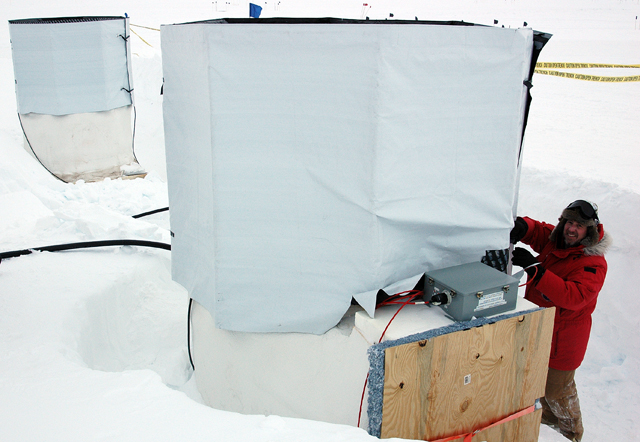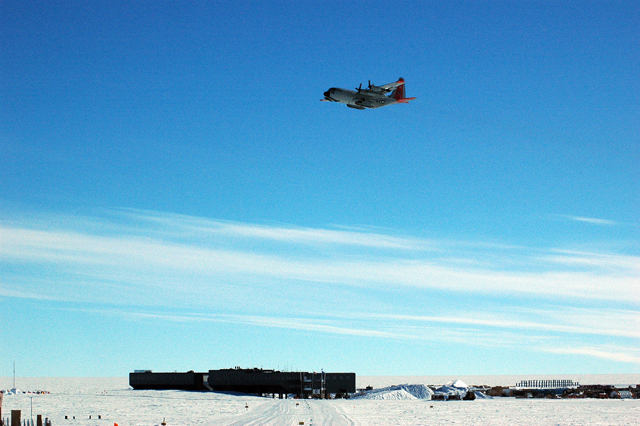Page 3/3 - Posted December 31, 2010
Running hot and coldDuling also dates his involvement with IceCube back to the AMANDA days, an effort in the mid 1990s that resulted in 19 strings at more shallow depths. The hotwater drill camp for the bigger and deeper IceCube array consists of a set of modular buildings, appearing like a pair of cargo trains frozen to the ice. A web of hoses runs between the parallel buildings, heating and transporting thousands of gallons of water. The system includes its own Rod well, a sort of underground aquifer of water in the ice that is maintained by hot water circulation. At the end of the system is a 10,000-kilogram hose, which shoots water out at 750 liters per minute at a temperature of 88 degrees Celsius. It takes about 75,000 liters of water to melt a hole wide and deep enough for each string of detectors. This all happens at a place where even summertime temperatures rarely reach above minus 20 degrees Celsius. “The South Pole is one of the worst places to run hotwater, or water of any kind, through a pipe,” Duling said. “It takes a lot of people and a lot of equipment.” Topped offThe “discovery machine” is a multifaceted tool. Originally designed to look downward as neutrinos shot through the Earth from the Northern Hemisphere — using the planet as a natural filter — the IceCube array can also look above to the south. The primary tool for looking at cosmic rays (energetic subatomic particles) from the Southern Hemisphere is IceTop. The University of Delaware “It’s a big cosmic ray detector,” said James Roth with the University of Delaware. His team installed the last 2,200-liter IceTop tank, each of which holds two half-submerged DOMs, about a week before the final string deployment. The frozen water in each tank is as clear as that deep in the ice sheet. His team uses an instrument at the bottom of the tank to remove the dissolved gases that cause the bubbles that cloud the ice. A little pond pump circulates the water through the apparatus. “It’s constantly removing the dissolved gases, and therefore we get perfectly clear ice,” said Roth, who has overseen the installation of all 162 IceTop tanks over the last seven seasons. Thomas Gaisser “I’m glad I was able to see it through and see it to the end. I’m excited that all of the tanks are filled now and things are freezing,” Roth said, explaining that it takes about 50 days for a tank to freeze completely at the South Pole. “It’s a little sad to know that this great group of people I’ve worked with for so long won’t be back here next year,” he added. Looking forwardThat may not entirely be the case. Work has already begun on a prototype for a different type of neutrino observatory at the South Pole that will detect even higher energy particles than IceCube. But instead of relying on Cherenkov light — the fleeting pulse of blue light in the ice — the proposed Askaryan Radio Array will search for radio waves produced by neutrino interactions in the ice. The radio pulses come from the particle showers produced when the neutrino converts its energy into matter. One radio test bed system, consisting of an antenna system on the snow surface, will be installed this season. The actual radio array, if funded, would be on a far larger scale than IceCube. “There are many ideas under way for how to use IceCube,” said Karle, the principal investigator on the Askaryan Radio Array project. “Once you create a reality like IceCube — something big — it opens the door [for more ideas].” Fitting, considering IceCube proposes to open a new window on our universe. “We now have a new decade ahead of us when exciting discoveries might come,” Papitashvili said. NSF-funded research in this story: Francis Halzen, University of Wisconsin-Madison, Award Nos. 0937462, 0236449, 0639286 and 0636875
|



For USAP Participants |
For The Public |
For Researchers and EducatorsContact UsU.S. National Science FoundationOffice of Polar Programs Geosciences Directorate 2415 Eisenhower Avenue, Suite W7100 Alexandria, VA 22314 Sign up for the NSF Office of Polar Programs newsletter and events. Feedback Form |





